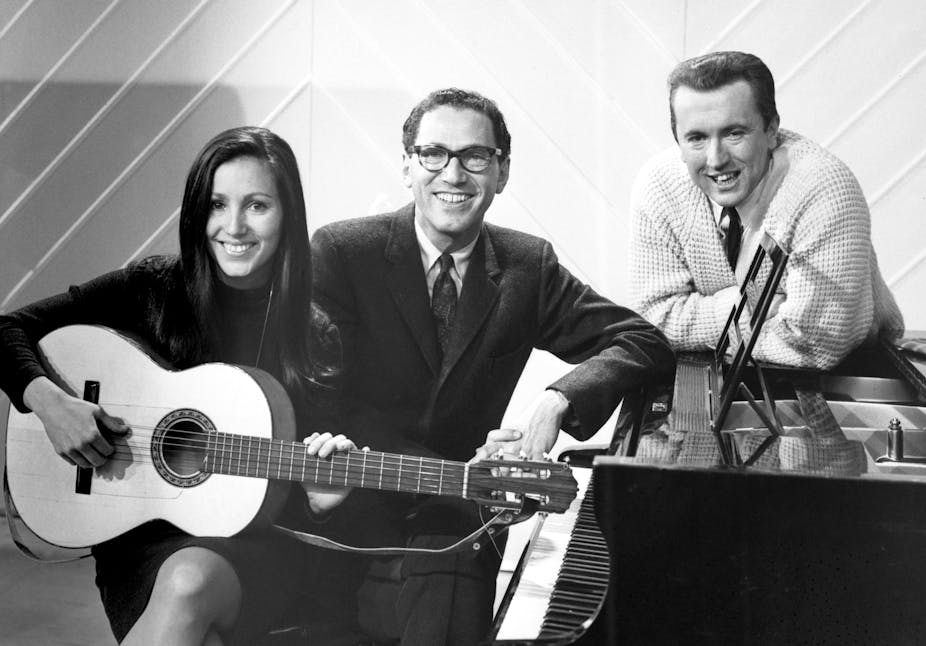Ten years ago my wife, the Broadway singer Judy Blazer, performed in a satirical revue for the Lyrics and Lyricists Series at New York’s 92nd Street Y. The programme drew heavily on the work of the satirist Tom Lehrer, who was honoured by having the entire show named after one of his songs: Poisoning Pigeons in the Park.
And what a different time that was to now. The Obamas were in the White House, which exuded an air of elegance and grace not seen since JFK’s Camelot. Still, in an interview about the show, Lehrer responded to the suggestion that his songs seemed to have come from an earlier, kinder, and gentler time. As he saw it, it was a question of comedic tone: “‘irreverence’ had been ‘subsumed by mere grossness … Irreverence is easy – what’s hard is wit’”.

Last week, Lehrer, now 92, hit the news with the announcement that he was putting the entire catalogue of his song lyrics into the public domain. They can now be performed and quoted endlessly. The question is, why should they be?
Two years ago, Lehrer mused upon the possibility of his own obsolescence: “Things I once thought were funny are scary now. I often feel like a resident of Pompeii who has been asked for some humorous comments on lava.”
How similar this sounds to the worries of another master comedian, Charlie Chaplin, who implied the same thing more than 80 years ago:
Modern humor frightens me a little. The Marx Brothers are frightening. Thurber, Stewart, Joe Cook, Benchley – yes, all of them. They say, 'All right, this is how we live and we’ll live that way.’ They go in for being crazy. It’s a soul-destroying thing. They say, ‘All right you’re insane, we’ll appeal to your insanity.’ They make insanity the convention. They make humor a premise. Acquiescence in everything disintegrating. Knocking everything down. Annihilating everything. There’s no conduct in their humor. They haven’t any attitude. It’s up-to-date, of course – a part of the chaos. I think it’s transitional.
In spite of his personal courtliness, Lehrer’s songs could be quite savage. Witness his contempt for the Nazi scientist, Wernher von Braun, designer of the V2 rocket that left London and other European cities in ruins. Far from facing judgement at Nuremburg, von Braun was drafted in to lead the US space programme after the war – all “to put some idiot on the moon”, as Lehrer sang:
Don’t say that he’s hypocritical.
Say, rather, that he’s apolitical.
“Once the rockets are up, who cares where they come down?
That’s not my department”, says Wernher von Braun.
Lehrer has played with some terrifying subjects in his day. As a mathematician who had once worked at the Los Alamos laboratory where the US atomic bomb was designed, he could cheerfully sing a thing or two about nuclear annihilation:
And we will all go together when we go.
What a comforting fact that is to know!
Universal bereavement –
An inspiring achievement!
Yes, we will all go together when we go.
And yet now, like Chaplin before him, Lehrer professes to be scared by what he sees around him. Comedians have often felt unequal to the task of engaging with the raw stuff of their satire. Lehrer once said: “Political satire became obsolete when Henry Kissinger was awarded the Nobel peace prize.”
In the early 1960s, the novelist Philip Roth – whose work The Plot Against America (2004), published 16 years before the Trump presidency, was recently dramatised by HBO – expressed a similar worry:
The American writer in the middle of the 20th century has his hands full in trying to understand, describe, and then make credible much of American reality. It stupefies, it sickens, it infuriates, and finally it is even a kind of embarrassment to one’s meagre imagination. The actuality is continually outdoing our talents, and the culture tosses up figures almost daily that are the envy of any novelist.
Unspeakably funny
Now, comedians and satirists are certainly thinking about how to handle the “figures” that American culture has tossed up for their raw material. They faced the same problem after the 2016 election – sometimes with sobering results.
In 2017, the comedian Kathy Griffin faced an onslaught of abuse and blacklisting after posing in photographs holding a Donald Trump mask, bloodied to look like a severed head. The following year – as I discussed in a previous article for The Conversation – Michelle Wolf was pilloried for calling out Trump’s racism, misogyny and mendacity in the starkest of terms at the White House Press Correspondents’ Dinner. Undoubtedly they were terms that Tom Lehrer would not have used.
But at the same time, today’s unspeakable terms are likely to get tomorrow’s green light. The late Texan comedian Bill Hicks was censored and cut from the David Letterman show in 1993 for taking on Christian hypocrisy, with not a four-letter word uttered. Sixteen years later – with the comedian in his grave – Letterman brought Hicks’s mother on to the show to apologise to her personally and to air the entire cut segment. As he confessed: “I don’t know why, I’m sorry I did it, and it was a mistake.”
Times change. Yesterday’s “daring” is perhaps today’s “quaint”. But Lehrer has bequeathed to us a body of work that will always be relevant, even if he has felt unequal to the task of engaging with the horrors of today. We can certainly appreciate his influence in the work of the musical parodist Randy Rainbow, who has been taking on the world of Trump mercilessly and hilariously.
Tom Lehrer has given us a treasure trove for succeeding musical satirists to learn from and to build upon.

